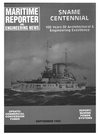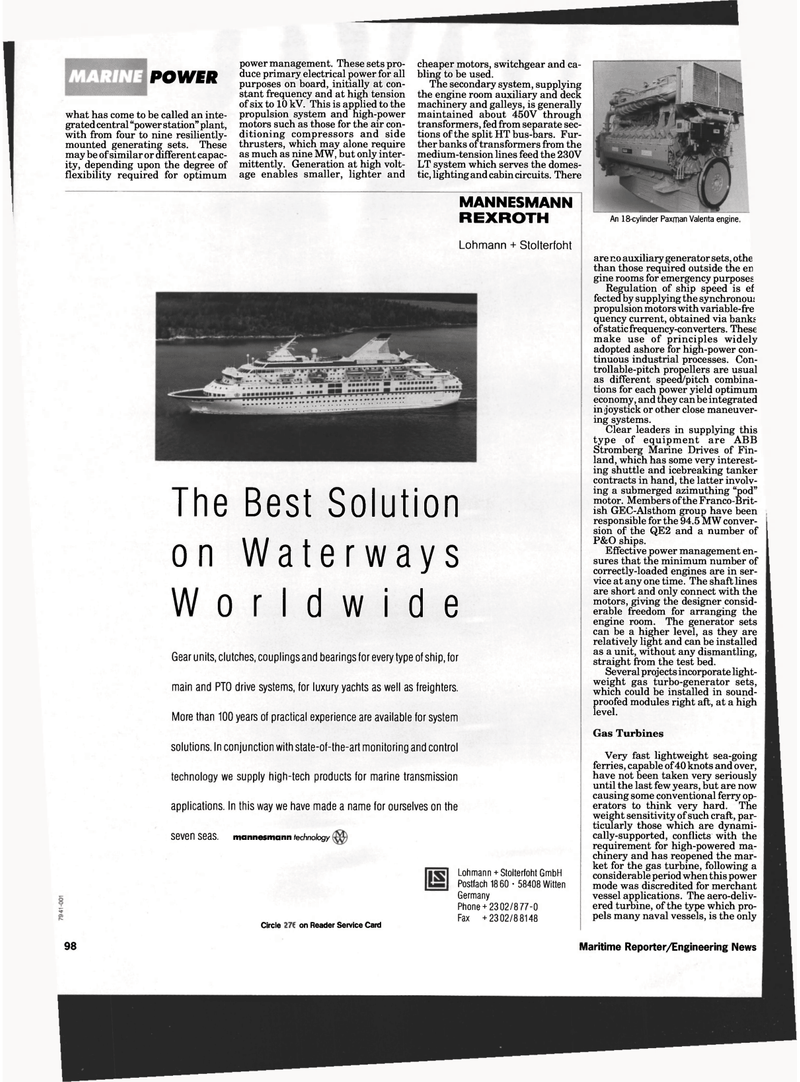
Page 104: of Maritime Reporter Magazine (September 1993)
Read this page in Pdf, Flash or Html5 edition of September 1993 Maritime Reporter Magazine
POWER what has come to be called an inte- grated central "power station" plant, with from four to nine resiliently- mounted generating sets. These may be of similar or different capac- ity, depending upon the degree of flexibility required for optimum power management. These sets pro- duce primary electrical power for all purposes on board, initially at con- stant frequency and at high tension of six to 10 kV. This is applied to the propulsion system and high-power motors such as those for the air con- ditioning compressors and side thrusters, which may alone require as much as nine MW, but only inter- mittently. Generation at high volt- age enables smaller, lighter and cheaper motors, switchgear and ca- bling to be used.
The secondary system, supplying the engine room auxiliary and deck machinery and galleys, is generally maintained about 450V through transformers, fed from separate sec- tions of the split HT bus-bars. Fur- ther banks of transformers from the medium-tension lines feed the 230V
LT system which serves the domes- tic, lighting and cabin circuits. There
MANNESMANN
REXROTH
Lohmann + Stolterfoht
The Best Solution on Waterways
Worldwide
Gear units, clutches, couplings and bearings for every type of ship, for main and PTO drive systems, for luxury yachts as well as freighters.
More than 100 years of practical experience are available for system solutions. In conjunction with state-of-the-art monitoring and control technology we supply high-tech products for marine transmission applications. In this way we have made a name for ourselves on the
Seven SeaS. mannesmann technology
Circle 318 on Reader Service Card
Lohmann + Stolterfoht GmbH
Postfach 1860 • 58408 Witten
Germany
Phone + 2302/877-0
Fax +2302/88148
An 18-cylinder Paxman Valenta engine. are no auxiliary generator sets, othe than those required outside the en gine rooms for emergency purposes
Regulation of ship speed is ef fected by supplying the synchronous propulsion motors with variable-fre quency current, obtained via banks of static frequency-converters. These make use of principles widely adopted ashore for high-power con- tinuous industrial processes. Con- trollable-pitch propellers are usual as different speed/pitch combina- tions for each power yield optimum economy, and they can be integrated in joystick or other close maneuver- ing systems.
Clear leaders in supplying this type of equipment are ABB
Stromberg Marine Drives of Fin- land, which has some very interest- ing shuttle and icebreaking tanker contracts in hand, the latter involv- ing a submerged azimuthing "pod" motor. Members of the Franco-Brit- ish GEC-Alsthom group have been responsible for the 94.5 MW conver- sion of the QE2 and a number of
P&O ships.
Effective power management en- sures that the minimum number of correctly-loaded engines are in ser- vice at any one time. The shaft lines are short and only connect with the motors, giving the designer consid- erable freedom for arranging the engine room. The generator sets can be a higher level, as they are relatively light and can be installed as a unit, without any dismantling, straight from the test bed.
Several projects incorporate light- weight gas turbo-generator sets, which could be installed in sound- proofed modules right aft, at a high level.
Gas Turbines
Very fast lightweight sea-going ferries, capable of 40 knots and over, have not been taken very seriously until the last few years, but are now causing some conventional ferry op- erators to think very hard. The weight sensitivity of such craft, par- ticularly those which are dynami- cally-supported, conflicts with the requirement for high-powered ma- chinery and has reopened the mar- ket for the gas turbine, following a considerable period when this power mode was discredited for merchant vessel applications. The aero-deliv- ered turbine, of the type which pro- pels many naval vessels, is the only 98 Maritime Reporter/Engineering News

 103
103

 105
105
